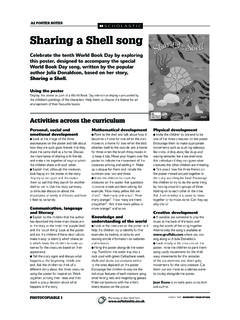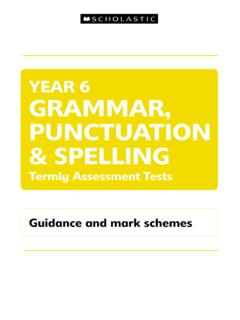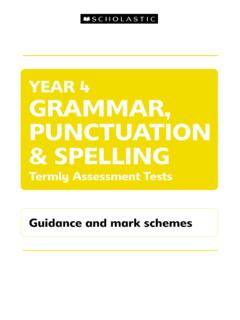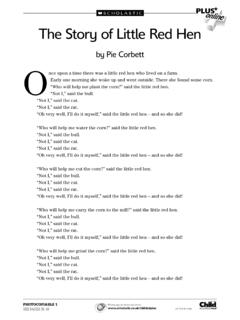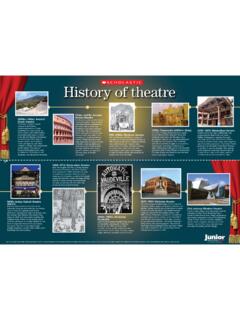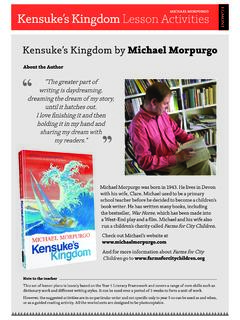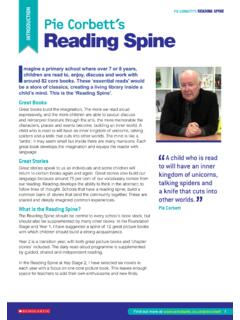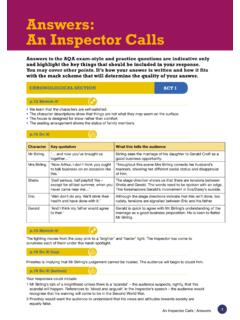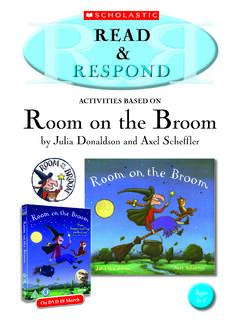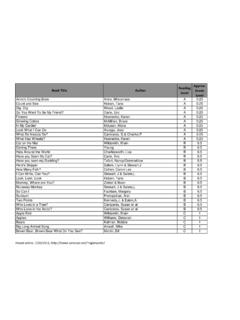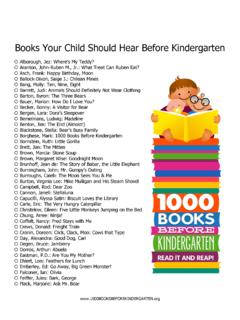Transcription of Pie Corbett’s Reading Spine - Scholastic UK
1 PIE corbett S Reading SPINEPie corbett sReading SpineNURSERYThe books that I have chosen are almost all very repetitive and rather like songs! This makes them easier for children to join in with so that the experience of Reading becomes interactive and the children begin to learn the story as they are read to. In each book there will be much to discuss so that the children understand the vocabulary as well as what is happening. All of the books have pictures, which support the text but also compliment and add to it. It is important to discuss the pictures and what is happening in them as much as the text. After a while, the children will get to know each story word for word, which can give great confidence to early readers in terms of fluency when Reading . Where s Spot? Eric Hill (Puffin)Both this book and dear zoo work on the same principle of involving the child in the act of Reading by using flaps so that the process becomes interactive.
2 Both books can be used to create new versions by hiding a different animal under homemade flaps. Use the game of hide and seek when Zoo Rod Campbell (Puffin)This book is a gateway into learning about different animals. The repetition of so will add a new conjunction to a child s repertoire. Discuss the reasons for sending the animals back heavy, fragile, tall, dangerous, fierce, grumpy, with care , scary, naughty, jumpy and perfect. Use masks or toys or puppets and involve the children in the story, playing different Choose Pippa Goodhart and Nick Sharratt (Random House)This classic book is good to share many times, especially working closely with a few children so they can look at the pictures and choose. Invite children to make collections organising toys or objects into different categories. Play sorting games by size, colour, shape or type. Use the book many times to choose a main character, a setting, an animal or object.
3 Use these selections then to make up simple stories. The book can be used endlessly for this as the combinations are almost infinite!.Find out more at corbett S Reading SPINENURSERYWe re Going on a Bear Hunt Michael Rosen (Walker Books)Learn the story orally, map it and act it out outside. Ask: Why does the writer say we re not scared at the very start of the story? Who is scared? Talk about how everyone feels at different points. Ask: Was the bear angry or did he just want a friend? Look at the different places and invent other onomatopoeic phrases (swishy swashy). Draw a new map, perhaps of the local area, and create a new version. Act or sing the new version, with costumes or puppets and film it for parents. (See the read & Respond title for further ideas.) Brown Bear, Brown Bear, What Do You See? Bill Martin Jnr and Eric Carle (Windmill Books) read , enjoy and let children join in until they know the story. Leave copies around so they can play at Reading .
4 Discuss what else the animals might hear, touch, taste or see. Ask: How do the different colours make you feel? Which is your favourite? Create a different version of the story for other animals that the children know, such as a cat or dog. Create tissue collages using primary colours or bold paintings of animals. Also, read Polar Bear, Polar Bear, What Do You Hear? by the same s Beanstalk Nick Butterworth and Mick Inkpen (Hodder)This story makes a neat precursor to The Very Hungry Caterpillar as it shows how to make up a simple story by repeating the days of the week and describing what happens on each day. Ask: Who is Jasper and what is a beanstalk? read this in the Spring when you can grow some beanstalks and tell the children the slightly scary story of Jack and the Beanstalk . Discuss what happens at the end of this story and then decide with the children what happens to Jasper at the top of the beanstalk!The Very Hungry Caterpillar Eric Carle (Puffin)Share until the children know the story well.
5 Ask: Who is Christa ? Discuss the idea of the author/artist making the book for someone else. Create collages of the moon at night, leaves and trees. Notice the alliteration (light/ little/ lay/ leaf) and the introduction of another conjunction but . Ideal for getting a sense of days of the week, different fruit (bring in a selection) and growing! Of course, some of this work might best be done in the spring/summer when you can hatch out butterflies or at least see some outside! Paint huge, vibrant Maclary from Donaldson s Dairy Lynley Dodd (Puffin) read this story many times with everyone joining in and savouring the rhymes. Ask: Which is the favourite dog? Who is the least favourite? Tr y inventing other similes instead of as big as a horse , for example, as big as a car ! Collect and list rhyming words. Play games to hear which words rhyme and which do not. Talk about names that we give out more at out more at corbett S Reading SPINEEach Peach Pear Plum Allan and Janet Ahlberg (Puffin) read together and look carefully at each picture.
6 Tell the class the stories or rhymes behind each of the characters. Make sure that the story books are available for the children to look at. Chant the book together and try inventing a rhythmic clap as a chorus between each page. Provide puppets or costumes and objects from the stories for play. (See the read & Respond title for further ideas.) The Train Ride June Crebbin (Walker Books)Ideally, take the children on a train! If not, then use film and toys. Ask: Who has been on a car or bus journey? Where did you go and what did you see? Who is the lady with the child? What is the town and what is the countryside? There is plenty to discuss in the story animals, meadows, hills, farms, tractors, tickets, tunnels, the seaside, lighthouse and sand. Ask: Why are they travelling to Gran s? Bring in a mirror so that everyone can see themselves. Make seaside small worlds using sand and water. Change the story and have a child coming from the country into the city and ask: What would they see?
7 Lay out a train Jez Alborough (Walker Books)In this book there are of course lots of the different animals to name, but it is also important to let the children tell you how the monkey and the other animals feel and what they might be thinking. Get some sticky notes in the shape of speech bubbles and add in what characters might say or think. Avoid the temptation to tell the children! Make masks and play at the story use toys or puppets to re-enact. Try making up the whole story with the class, write this up and turn it into a Big Book. The theme of losing a mother also features in Come on, Daisy! and in the Reception book Owl on, Daisy! Jane Simmons (Orchard Books)Some children might have noticed by now the question marks in certain book titles and here we are now with an exclamation mark as well! Start with the cover. Ask: Who is speaking, to whom and what might it mean? What do you think will happen in the story? Why must Daisy stay close?
8 Talk about: I ll try . Track Daisy s feelings. Emphasise the but construction when Reading with children joining in. Ask: Are the dangers real? What is the book about? What is it telling us to do when we go out with Mum or Dad?NURSERYFind out more at
